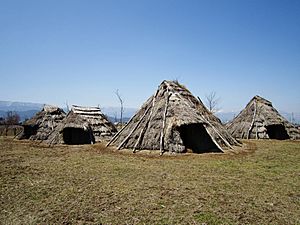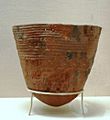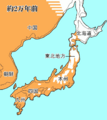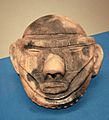Jōmon period facts for kids
 |
|---|
|
The Jōmon period is the time in Japanese prehistory, traditionally dated between c. 14,000–300 BCE, recently refined to about 1000 BCE, during which Japan was inhabited by a hunter-gatherer culture, which reached a considerable degree of cultural complexity. The name "cord-marked" was first applied by the American scholar Edward S. Morse, who discovered sherds of pottery in 1877 and subsequently translated it into Japanese as jōmon.
The pottery style characteristic of the first phases of Jōmon culture was decorated by impressing cords into the surface of wet clay and is generally accepted to be among the oldest in East Asia and the world.
The Jōmon period was rich in tools and jewellery made from bone, stone, shell and antler; pottery figurines and vessels; and lacquerware. It is often compared to pre-Columbian cultures of the North American Pacific Northwest and especially to the Valdivia culture in Ecuador because in these settings cultural complexity developed within a primarily hunting-gathering context with limited use of horticulture.
Foundation myths
The origin myths of Japanese civilization extend back to periods now regarded as part of the Jōmon period, though they show little or no relation to what we know archaeologically of Jōmon culture. 11 February 660 BCE is the traditional founding date of the Japanese nation by Emperor Jimmu. This version of Japanese history, however, comes from the country's first written records, the Kojiki and Nihon Shoki, dating from the 6th to the 8th centuries, after Japan had adopted Chinese characters.
Some elements of modern Japanese culture may date from this period and reflect the influences of a mingled migration from the northern Asian continent and the southern Pacific areas and the Jōmon peoples. Among these elements are the precursors to Shinto, some marriage customs, architectural styles, and technological developments such as lacquerware, laminated yumi, metalworking, and glass making.
Related pages
Images for kids
-
Reconstruction of the Sannai-Maruyama Site in the Aomori Prefecture. The site shares cultural similarities with settlements of Northeast Asia and the Korean Peninsula, as well as with later Japanese culture, pointing to continuity between ancient and modern Japanese culture.
-
Incipient Jōmon pottery (14th–8th millennium BCE) Tokyo National Museum, Japan
-
Azuki bean cultivation was common in southern Jōmon period Japan and also in southern China and Bhutan.
-
Jōmon clay mask, bearing similarities to clay masks found in the Amur region.
-
The Magatama is a famous jewelry from Jōmon period Japan, and was also found in the Korean Peninsula and Northeast Asia.
-
Reconstruction of a Jōmon period houses in the Aomori Prefecture.
-
Jōmon period clay figure from the Yamanashi Prefecture.
-
Late Jomon clay statue, Kazahari I, Aomori Prefecture, 1500–1000 BCE.
-
Late Jomon clay head, Shidanai, Iwate Prefecture, 1500–1000 BCE.
See also
 In Spanish: Período Jōmon para niños
In Spanish: Período Jōmon para niños




















